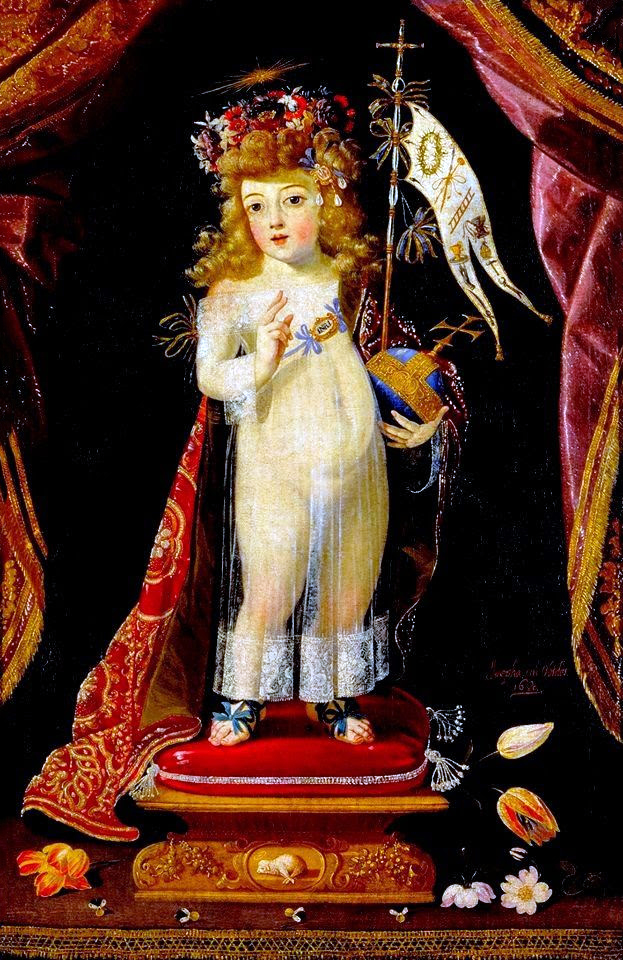
Josefa de Ayala, Christ Child as Salvator Mundi, signed and dated “Josepha em Obidos 1680,” oil on canvas, Third Penitential Order of Saint Francis, Coimbra
A woman artist in 17th-century Portugal
Josefa de Ayala, commonly called Josefa de Óbidos, is the only woman known to have worked as a painter in Portugal in the seventeenth century. After her death, publications about Portuguese artists celebrated her and marveled at the novelty of a woman artist. This painting of the Christ Child as Salvator Mundi (meaning savior of the world) is one of several versions that she painted near the end of her life.
Ayala painted Jesus as a toddler standing on a pedestal. He looks at the viewer and makes the sign of blessing while holding an orb and a flag. The sphere, divided into three parts, represents the Earth with the three continents—Europe, Africa, and Asia—that had been known to Europeans prior to their arrival in the Americas in the late 15th century. This depiction continued to be used to represent the entire Earth as under Christ’s domain. The orb surmounted by a cross also represents Jesus as the savior of the world. Above the crown of flowers on his head is a subtle halo composed of radiating rays of light. Transparent lace covers his otherwise naked body and a rich mantle is draped around his back. The bright colors of the figure, pedestal, and curtains contrast with the black background. This dramatic lighting and attention to reality effects (replicating observed reality) are characteristic of the naturalistic Baroque style that was popular during this period. The painting of the Christ Child as Salvator Mundi is signed and dated in gold above the tulips near Jesus’ feet.
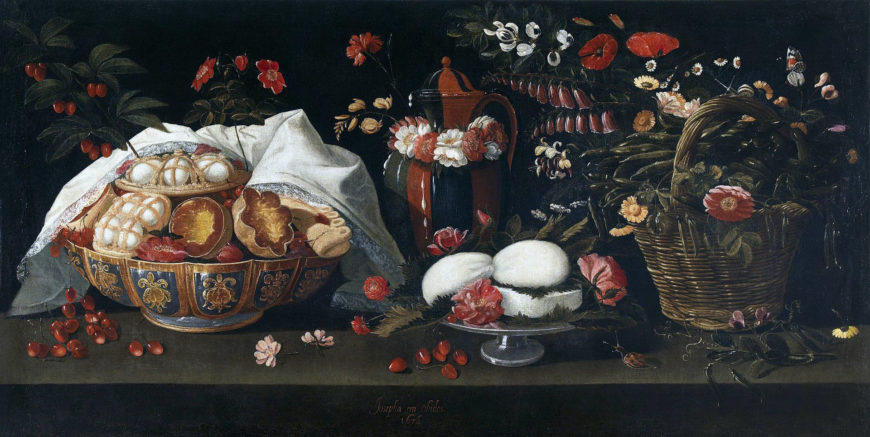
Josefa de Ayala, Still Life with Flowers and Sweets, 1676, oil on canvas, 85 x 169.5 cm (Museu Municipal de Santarém)
During Josefa de Ayala’s lifetime, Portugal was financially unstable and frequently at war. At her birth in 1630, Portugal was under Spanish rule, and only regained some of its former wealth and power after several decades. Nonetheless, Ayala worked in a region with wealthy art patrons. Although her hometown Óbidos was small, it was located between Lisbon, the capital, and Coimbra, the site of a university. In fact, many of her artworks were made for patrons in Coimbra.
Family of artists
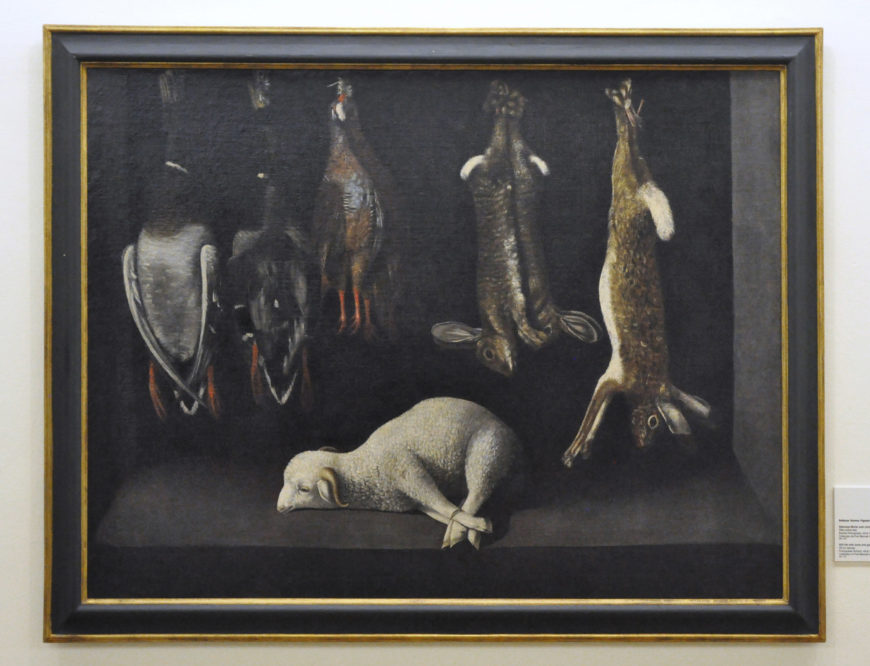
Baltazar Gomes Figueira, Still Life with Lamb and Game, c. 1650, oil on canvas (Museum of Évora; photo: jaime.silva, CC BY-NC-ND 2.0)
As was common for women artists in Europe, Ayala learned to paint from her father, Baltazar Gomes Figueira. While little is known about Ayala’s training, she probably assisted her father in his workshop from a young age.
Originally from Portugal, her father completed his artistic training in Seville, Spain where he married and where Josefa was born. Although Figueira is primarily known for his still life and landscape paintings, he also created religious scenes.
When Ayala was a child, she moved to Portugal and settled in Óbidos. She often referenced her hometown when signing her paintings “Josepha em Obidos” (Josefa in Óbidos).
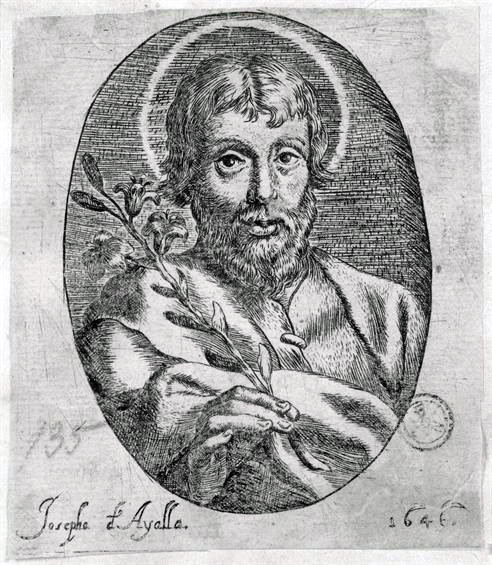
Josefa de Ayala, Saint Joseph, 1646, engraving, 8.2 x 5.8 cm (Museu Nacional de Arte Antiga, Lisbon)
Ayala’s first known published artworks, created while still a teenager, are three engravings, a technique that few artists in Portugal practiced at the time. The engraving of Saint Joseph shows Ayala’s attention to anatomy and her ability to meticulously work on a small scale.
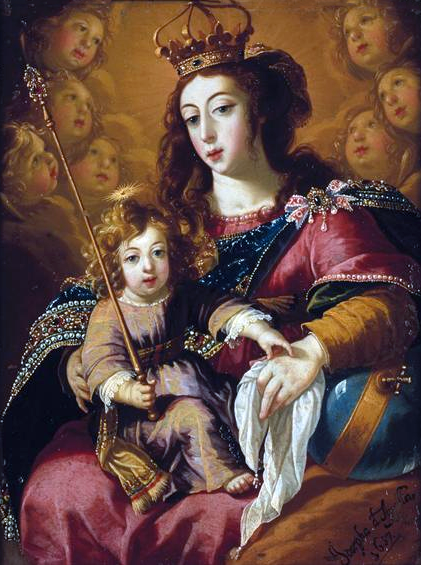
Josefa de Ayala, Virgin and Child, 1657, oil on copper, 16.2 x 12.5 cm (Museu Nacional de Arte Antiga, Lisbon)
Her earliest paintings were on copper. Paintings on copper are typically small and allow for intricate detail and a smooth surface. Her Virgin and Child is less than 6.5 inches tall, yet individual strands of hair are visible and each pearl ornamenting the jewelry and clothing is shaded to look three-dimensional. Figueira may have taught his daughter these media because they were considered particularly marketable and suitable for women. Small-scale work would have allowed a woman to work from home without needing to travel to churches, and engraving lends itself to commercial purposes, such as book illustration.
Although no concrete evidence has yet been found, Josefa de Ayala may have spent time living at two convents in the city of Coimbra—as early biographies mention (bu without providing any evidence). She does not seem to have been a nun, but if she did at one point live at a convent, it would have allowed her to focus on refining her artistic skills without pressure to marry. Overall, Ayala’s training prepared her to support herself financially.
Attention to still life
Ayala’s father may have introduced still life painting to Portugal. His paintings feature the dark colors and naturalistic textures of Spanish still life painting of this period. Ayala also produced still lifes, some in collaboration with her father.
The Christ Child painting incorporates objects and iconographic details that allowed her to draw on her skill with still life. Jesus holds a staff with symbols of the torments of the Passion, and the lamb on the pedestal refers to Jesus as the sacrificial lamb. The flowers in particular emphasize Ayala’s interest in still life. During this time, a still life painter was commonly referred to in Portuguese as floreiro meaning flower painter. [1]
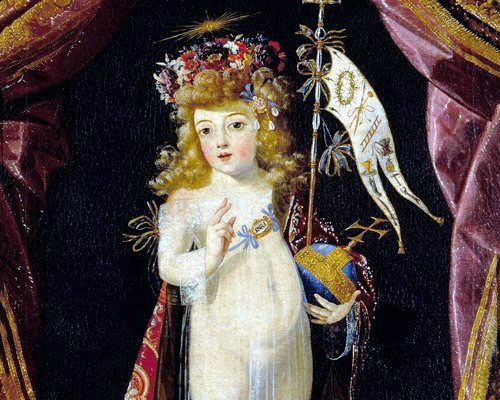
Josefa de Ayala, Christ Child as Salvator Mundi, signed and dated “Josepha em Obidos 1680,” oil on canvas, Third Penitential Order of Saint Francis, Coimbra
Feminine virtues?
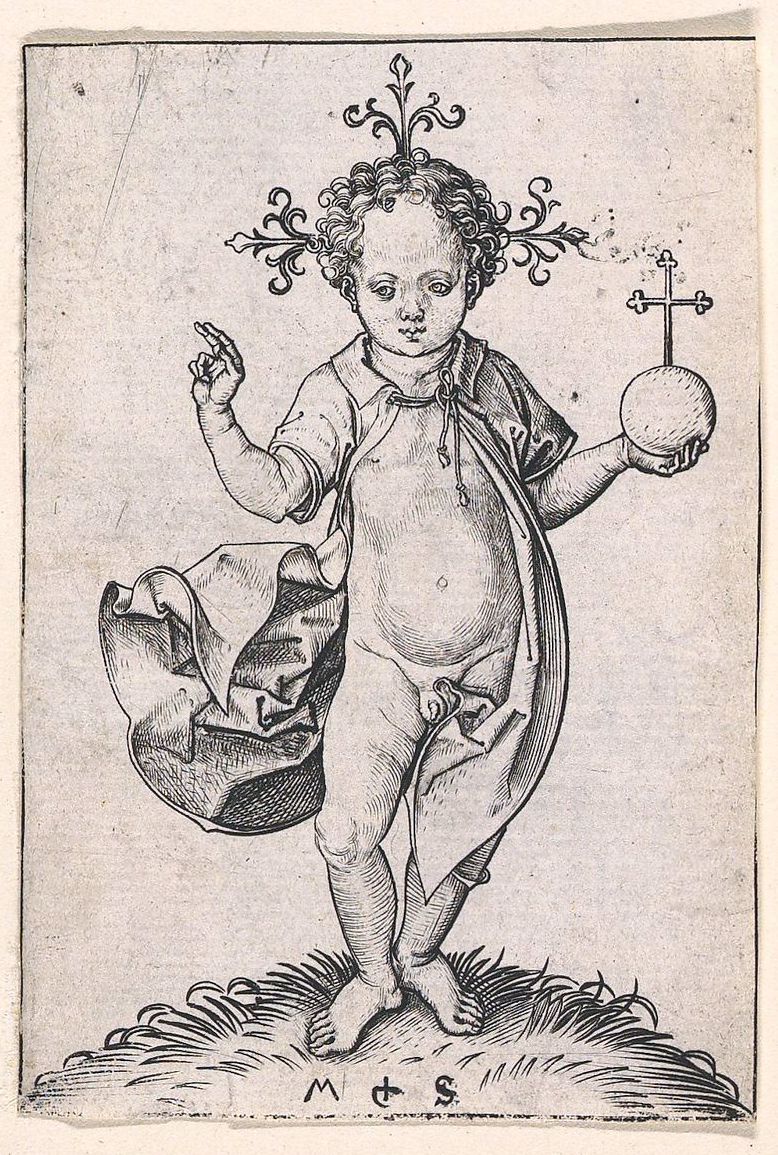
Martin Schongauer, The Christ Child with and Orb, 1469-83, engraving, 8.8 × 6 cm (The Metropolitan Museum of Art)
Ayala became a successful professional painter who traveled, interacted with clients, and conducted business—activities considered the domain of men. Like other women, such as the Italian painter Sofonisba Anguissola, Ayala often emphasized feminine virtues in her work. The Christ Child as Salvador Mundi highlights religious devotion, and maternal affection (as discussed below). More often, the adult Jesus is shown as the Salvator Mundi; however, images of the Christ Child in this role became popular throughout the Catholic world with the circulation of prints, such as Martin Schongauer’s version of this subject. The print, like Ayala’s painting, shows Jesus naked with the plump body of a baby to emphasize his innocence and vulnerability. To maintain the chaste reputation expected of an unmarried woman, Ayala added a translucent gown with strategically placed folds that catch the light and hide the figure’s genitals.
Women were encouraged to foster a maternal relationship with the Christ Child in emulation of the Virgin Mary, such as women who became nuns. When entering the convent, girls would sometimes receive dolls of the Christ Child. They acted as mother to the doll while also being spiritually married to Jesus as nuns. [2] If Ayala indeed lived in convents, she may have participated in the care of a Christ child doll. Her personal experience with such a doll could have been one reason why she made multiple paintings of the Christ Child.
It wasn’t only nuns who nurtured depictions of baby Jesus though. To this day, Ayala’s Christ Child as Salvator Mundi is owned by the confraternity known as the Third Penitential Order of Saint Francis, Coimbra, a group of men and women who perform charitable acts in the name of Saint Francis. [3] With the pedestal, curtains, and strewn flowers, the painting creates the illusion of a sculpture on an altar that has come to life.
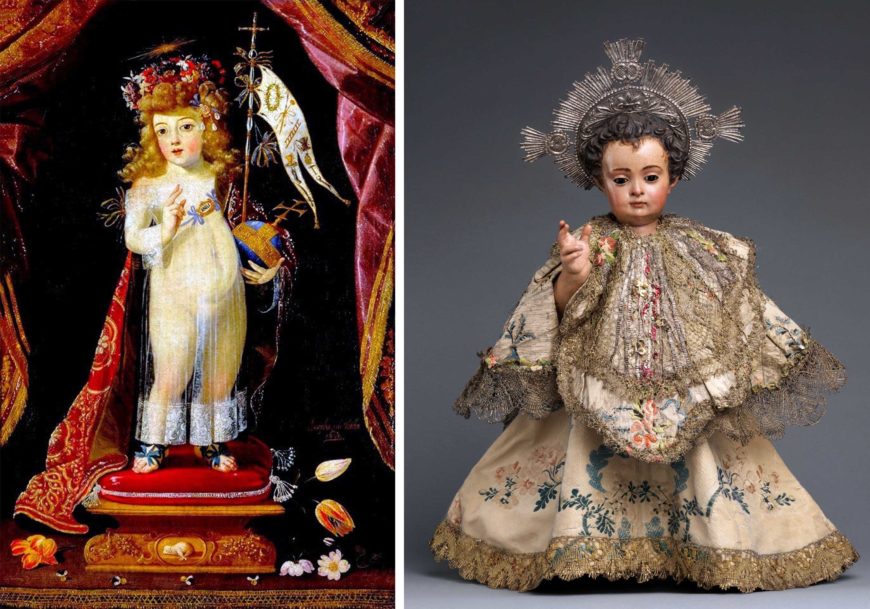
Left: Josefa de Ayala, Christ Child as Salvator Mundi, signed and dated “Josepha in Obidos 1680,” oil on canvas, Third Penitential Order of Saint Francis, Coimbra; right: Juan de Mesa, The Child Jesus Triumphant, c. 1625, polychromed lead, glass, silver, silk and silver-gilt lace, 40.6 × 15.6 × 15.2 cm (The Metropolitan Museum of Art)
In Spain and Portugal, altars often displayed sculptures that were painted, inlaid with glass eyes, and dressed in real clothing to appear as naturalistic as possible. Christ Child sculptures also stood on altars, and were presented with gifts of lavish clothing and flowers, especially during Christmas celebrations. [4] Ayala’s painting visualizes the practice of caring for Christ Child sculptures, dressing them and celebrating them with rich gifts. In this way, her painting is reminiscent of paintings that portray a specific, typically famous, sculpture on an altar. Such paintings were popular throughout the Spanish empire (such as images of Our Lady of Cocharcas) but were less common in Portugal.
An emancipated woman
Ayala was both a successful painter and a skilled business woman. When she was 29 years old, she received her parents’ permission to be a “Donzela emancipada,” an emancipated woman, unmarried and independent from her family. Although Ayala received many commissions for paintings, most of her wealth stemmed from real estate investments. The fact that she signed many of her artworks, such as the Christ Child as Salvator Mundi, not only attracted clients but prevented her from being forgotten after her lifetime.




